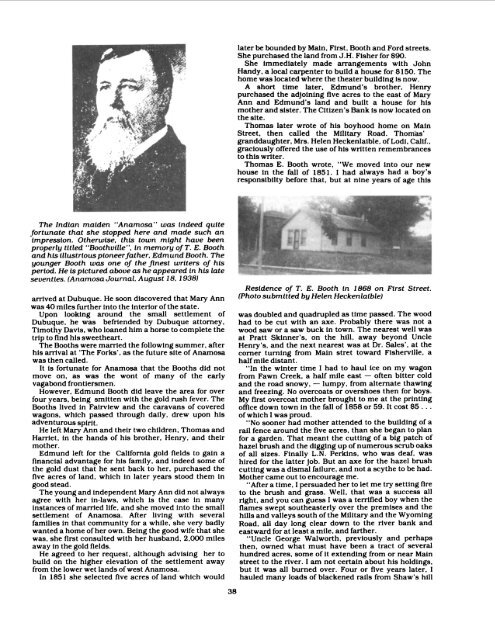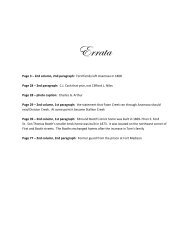Anamosa - A Reminiscence 1838 - 1988
The definitive history of the community of Anamosa, Iowa, USA
The definitive history of the community of Anamosa, Iowa, USA
You also want an ePaper? Increase the reach of your titles
YUMPU automatically turns print PDFs into web optimized ePapers that Google loves.
later be bounded by Main, First, Booth and Ford streets.<br />
She purchased the land from J .H. Fisher for $90.<br />
She immediately made arrangements with John<br />
Handy, a local carpenter to build a house for S 150. The<br />
home was located where the theater building is now.<br />
A short time later, Edmund's brother, Henry<br />
purchased the adjoining five acres to the east of Mary<br />
Ann and Edmund's land and built a house for his<br />
mother and sister. The Citizen's Bank is now located on<br />
the site.<br />
Thomas later wrote of his boyhood home on Main<br />
Street, then called the Military Road. Thomas‘<br />
granddaughter, Mrs. Helen Heckenlaible. of Lodi. Calif.,<br />
graciously offered the use of his written remembrances<br />
to this writer.<br />
Thomas E. Booth wrote, "We moved into our new<br />
house in the fall of 1851. I had always had a boy's<br />
responsibilty before that, but at nine years of age this<br />
The Indian maiden “<strong>Anamosa</strong>“ was indeed quite<br />
fortunate that she stopped here and made such an<br />
impression. Otherwise, this town might have been<br />
properly titled "Boothville", in memory of T. E. Booth<br />
and his illustrious pioneerfather, Edmund Booth. The<br />
younger Booth was one of the finest writers of his<br />
period. He is pictured above as he appeared in hislate<br />
seventies. (<strong>Anamosa</strong> Journal, A ugust 18. 1938)<br />
arrived at Dubuque. He soon discovered that Mary Ann<br />
was 40 miles further into the interior of the state.<br />
Upon looking around the small settlement of<br />
Dubuque, he was befriended by Dubuque attorney.<br />
Timothy Davis, who loaned him a horse to complete the<br />
trip to find his sweetheart.<br />
The Booths were married the following summer. after<br />
his arrival at ‘The Forks‘. as the future site of <strong>Anamosa</strong><br />
was then called.<br />
It is fortunate for <strong>Anamosa</strong> that the Booths did not<br />
move on, as was the wont of many of the early<br />
vagabond frontiersmen.<br />
However, Edmund Booth did leave the area for over<br />
four years. being smitten with the gold rush fever. The<br />
Booths lived in Fairview and the caravans of covered<br />
wagons, which passed through daily, drew upon his<br />
adventurous spirit.<br />
He left Mary Ann and their two children. Thomas and<br />
Harriet, in the hands of his brother, Henry. and their<br />
mother.<br />
Edmund left for the California gold fields to gain a<br />
financial advantage for his family. and indeed some of<br />
the gold dust that he sent back to her, purchased the<br />
five acres of land, which in later years stood them in<br />
good stead.<br />
The young and independent Mary Ann did not always<br />
agree with her in-laws, which is the case in many<br />
instances of married life, and she moved into the small<br />
settlement of <strong>Anamosa</strong>. After living with several<br />
families in that community for a while, she very badly<br />
wanted a home of her own. Being the good wife that she<br />
was, she first consulted with her husband, 2.000 miles<br />
away in the gold fields.<br />
He agreed to her request, although advising her to<br />
build on the higher elevation of the settlement away<br />
from the lower wet lands of west <strong>Anamosa</strong>.<br />
In 1851 she selected five acres of land which would<br />
fi<br />
Residence of T. E. Booth in 1868 on First Street.<br />
(Photo submitted by Helen Heckenlaible)<br />
was doubled and quadrupled as time passed. The wood<br />
had to be cut with an axe. Probably there was not a<br />
wood saw or a saw buck in town. The nearest well was<br />
at Pratt Skinner's, on the hill. away beyond Uncle<br />
Henry's, and the next nearest was at Dr. Sales‘, at the<br />
corner tuming from Main stret toward Fisherville, a<br />
half mile distant.<br />
“In the winter time I had to haul ice on my wagon<br />
from Fawn Creek. a half mile east — often bitter cold<br />
and the road snowy, — lumpy, from alternate thawing<br />
and freezing. No overcoats or overshoes then for boys.<br />
My first overcoat mother brought to me at the printing<br />
office down town in the fall of 1858 or 59. It cost $5 . . .<br />
of which I was proud.<br />
“No sooner had mother attended to the building of a<br />
rail fence around the five acres. than she began to plan<br />
for a garden. That meant the cutting of a big patch of<br />
hazel brush and the digging up of numerous scrub oaks<br />
of all sizes. Finally L.N. Perkins. who was deaf. was<br />
hired for the latter job. But an axe for the hazel brush<br />
cutting was a dismal failure, and not a scythe to be had.<br />
Mother came out to encourage me.<br />
“After a time, I persuaded her to let me try setting fire<br />
to the brush and grass. Well, that was a success all<br />
right. and you can guess I was a terrified boy when the<br />
flames swept southeasterly over the premises and the<br />
hills and valleys south of the Military and the Wyoming<br />
Road. all day long clear down to the river bank and<br />
eastward for at least a mile, and farther.<br />
“Uncle George Walworth, previously and perhaps<br />
then, owned what must have been a tract of several<br />
hundred acres, some of it extending from or near Main<br />
street to the river. I am not certain about his holdings.<br />
but it was all burned over. Four or five years later, I<br />
hauled many loads of blackened rails from Shaw's hill



